Traditional organic refined Shochu: Nanako
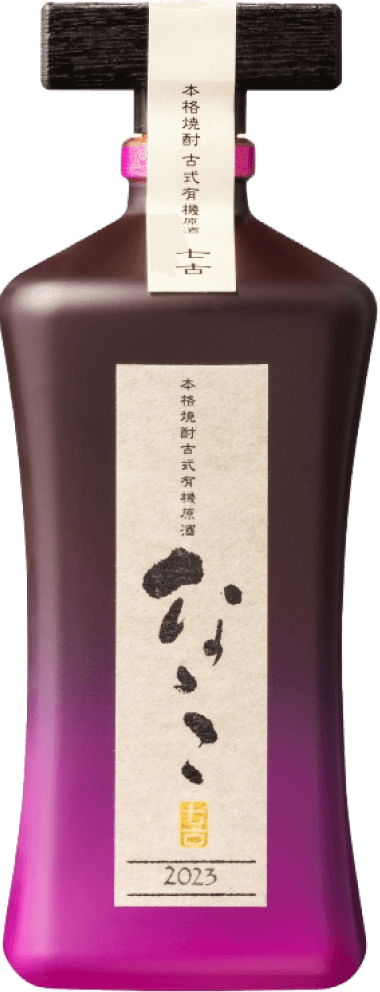
The ancient taste has come back to life The classic Shochu expresses a strong presence of sweet potatoes.
Nanako has seven features dating back to olden times.
1.Use of Aspergillus oryzae, the oldest Yellow koji mold that exists in Japan
2.Use of Saccharomyces sake, the first-generation isolated yeast that has survived to this day
3.Use of organic rice and sweet potatoes (certified organic producer)
4.Use of groundwater originating from “Mt. Kanmuri,” a sacred mountain in ancient times
5.Traditionally handed-down method, made by hand by Denbee master distillers
6.Fermentation and storage in age-old earthen jars
7.Distillation in barrels of cedar wood modeled on the ones used in older times
- Category
- Sweet Potato Honkaku Shochu
- Raw ingredients
- Sweet Potato (Kagoshima Prefecture), Rice Koji (Domestic Rice)
- Koji mold
- Yellow
- Alcohol
- 37%
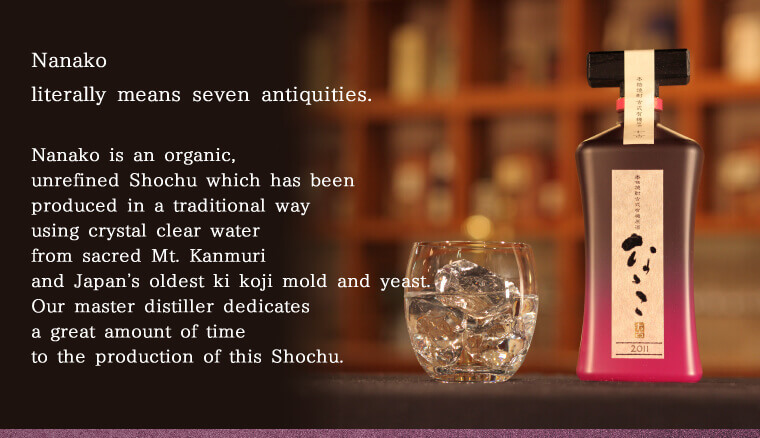
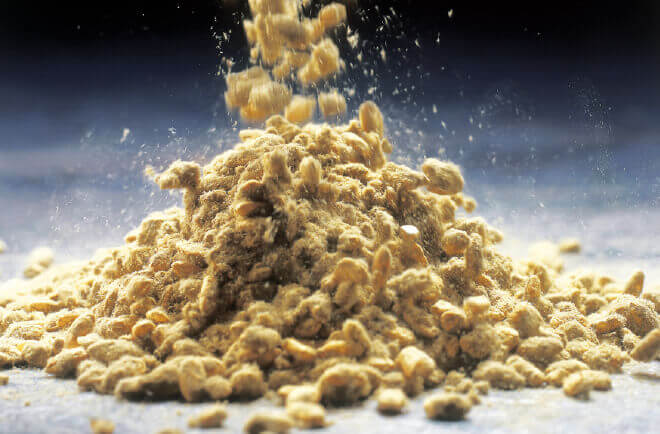
Yellow koji mold and the special yeast make this Shochu very special.
Attempts had been made to bring back the ancient taste and flavor before we finally found the koji mold and yeast that had been passed down over centuries. The koji mold we use is Japan’s oldest seed mold named Aspergillus oryzae, a strain of Yellow koji mold used widely in sake production. The yeast we use is the first-generation isolated yeast named Saccharomyces sake that has survived to this day.
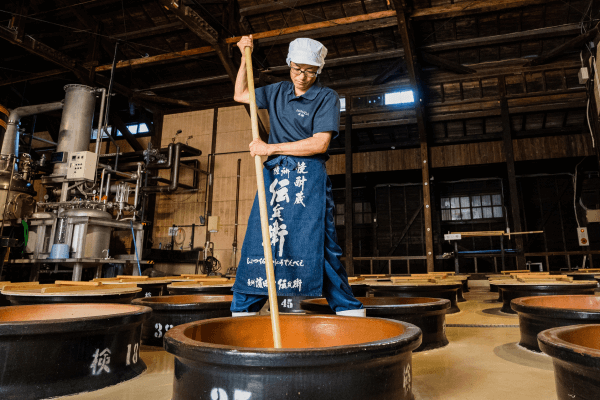
Traditional method of fermentation in the jar was the standard in the Meiji period.
Fermentation and aging in jars is the traditional Shochu making method passed down from the Meiji period. The large jars placed in a long line are more than 100 years old. Master distillers have a firm grasp of the characters of the jars of different ages and sizes. Round-shaped jars have circulation occurring inside, which reduces temperature irregularity during fermentation. Earthen jars emit ultra-red rays, which makes Shochu stored in them milder in taste.
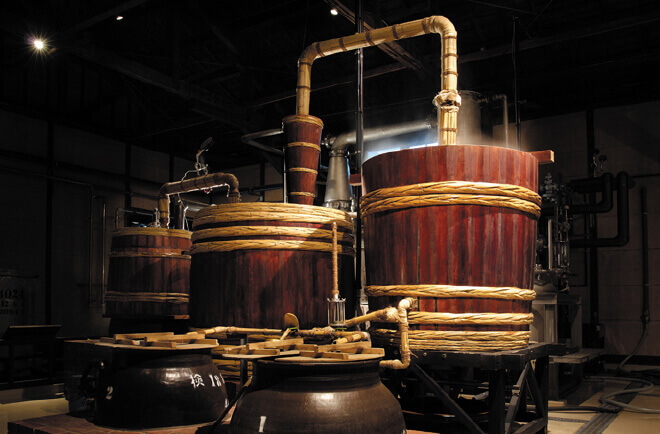
The wooden barrel distiller has been brought back to life to maintain the traditional taste.
Widely used from the Edo to Meiji periods, wooden barrel distillers were heated by steam blown into them. Wooden barrel distillers are difficult to maintain because they need repair every few years due to the damaging effect of heat and the acid content of moromi (fermenting mash). Denbeegura has them maintained carefully by the only professional wooden barrel maker remaining in Kagoshima Prefecture. This is done in order to maintain the taste of traditional Satsuma Honkaku Shochu.
Yellow koji mold and the special yeast make this Shochu very special.
Attempts had been made to bring back the ancient taste and flavor before we finally found the koji mold and yeast that had been passed down over centuries. The koji mold we use is Japan’s oldest seed mold named Aspergillus oryzae, a strain of Yellow koji mold used widely in sake production. The yeast we use is the first-generation isolated yeast named Saccharomyces sake that has survived to this day.
Traditional method of fermentation in the jar was the standard in the Meiji period.
Fermentation and aging in jars is the traditional Shochu making method passed down from the Meiji period. The large jars placed in a long line are more than 100 years old. Master distillers have a firm grasp of the characters of the jars of different ages and sizes. Round-shaped jars have circulation occurring inside, which reduces temperature irregularity during fermentation. Earthen jars emit ultra-red rays, which makes Shochu stored in them milder in taste.
The wooden barrel distiller has been brought back to life to maintain the traditional taste.
Widely used from the Edo to Meiji periods, wooden barrel distillers were heated by steam blown into them. Wooden barrel distillers are difficult to maintain because they need repair every few years due to the damaging effect of heat and the acid content of moromi (fermenting mash). Denbeegura has them maintained carefully by the only professional wooden barrel maker remaining in Kagoshima Prefecture. This is done in order to maintain the taste of traditional Satsuma Honkaku Shochu.


Yellow koji mold and the special yeast make this Shochu very special.
Attempts had been made to bring back the ancient taste and flavor before we finally found the koji mold and yeast that had been passed down over centuries. The koji mold we use is Japan’s oldest seed mold named Aspergillus oryzae, a strain of Yellow koji mold used widely in sake production. The yeast we use is the first-generation isolated yeast named Saccharomyces sake that has survived to this day.

Traditional method of fermentation in the jar was the standard in the Meiji period.
Fermentation and aging in jars is the traditional Shochu making method passed down from the Meiji period. The large jars placed in a long line are more than 100 years old. Master distillers have a firm grasp of the characters of the jars of different ages and sizes. Round-shaped jars have circulation occurring inside, which reduces temperature irregularity during fermentation. Earthen jars emit ultra-red rays, which makes Shochu stored in them milder in taste.

The wooden barrel distiller has been brought back to life to maintain the traditional taste.
Widely used from the Edo to Meiji periods, wooden barrel distillers were heated by steam blown into them. Wooden barrel distillers are difficult to maintain because they need repair every few years due to the damaging effect of heat and the acid content of moromi (fermenting mash). Denbeegura has them maintained carefully by the only professional wooden barrel maker remaining in Kagoshima Prefecture. This is done in order to maintain the taste of traditional Satsuma Honkaku Shochu.

